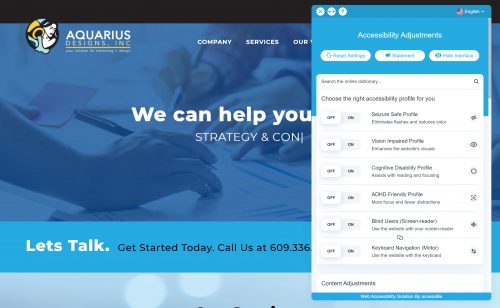Americans with Disabilities Act (ADA) Sets Standards for Accessible Design
The Americans with Disabilities Act (ADA) sets a standard for accessible design, and if yours isn’t fully compliant, you could find yourself in trouble. While ADA website compliance is not yet mandatory, making sure yours meets all standards can protect your business from a lawsuit. Afterall, visually impaired website users have been filing lawsuits against businesses over accessibility issues, and many of them were winning.
CLICK HERE TO MAKE AN APPOINTMENT
OR CALL US TODAY AT 917-687-4764
What Does It Do to My Website?
Small icon placed on bottom of website | Once icon is clicked – ADA menu appears |
How Aquarius Designs Can Help
If we’re building your site from scratch, your quote can include ADA-compliant designs.
If we’re working with your existing site, our team will perform a comprehensive site analysis and provide an estimate to fix compliance issues and bring your site into compliance with Section 508.
We have monthly or yearly plans available.
Are You Interested in Learning More?
Please fill out the form below whether you are intersted or not interested and we will provide customized information for your business.
What’s Going on Legally?
In short, increasingly attorneys have been threatening companies and orgs with lawsuits if their website is not “accessible”, with settlements ranging from $5,000 to $75,000 per instance if the company doesn’t “fix” their site. This has been ramping up year to year, as we move towards the increasing understanding of the needs of those with disabilities, and how to implement those features on existing websites.
What Is Web Accessibility?
At Aquarius Designs, we understand the ins and outs of web accessibility and our experts are here to ensure your website is ADA compliant. Our web developers achieve this by following the W3C’s (World Wide Web Consortium) Web Content Accessibility Guidelines 2.1 (WCAG 2.1) They have three levels, and as of the moment, to be considered accessible, a website has to meet WCAG 2.1 AA.
Web accessibility is a set of design rules, guidelines, and code standards that enable people with disabilities to use business websites effectively.
Technically speaking, accessibility is defined by the requirements laid out by Section 508 of the Rehabilitation Act of 1973, and it’s often conflated with the Americans with Disabilities Act (ADA).
Non-technically, it’s giving someone with a disability, like limited or no sight or hearing, the ability to experience all elements of your website. For example, someone without sight is not able to see images or form fields on your website, so they need alternative text to inform them as to the content of each image. Someone without hearing cannot listen to a narrated video, so they need captions.
Tax Credit
It is important that you check with your business’s tax professional before signing and sending in your annual accessibility expenditures. They can answer any questions. If you need help with a CPA with this type of experience, we can refer you to one.
The tax credit will cover 50% of a business’s accessibility-related expenditures for up to $10,250.
The first $250 is not covered, which means that your business would be entitled to $5,000 in credit.
Any business with an accessible website that employs no more than 30 full-time employees or generated less than $1 million the previous tax year is eligible.
If your business fits one of these two qualifications, the next step is to fill out form 8826, which is found on the IRS website, and attach it to your yearly tax return. More instructions can be found on page two of form 8826. You can also visit the IRS tax credits and deductions page on the Americans With Disabilities Act website for additional details.
